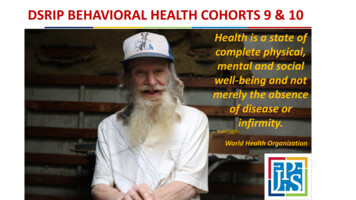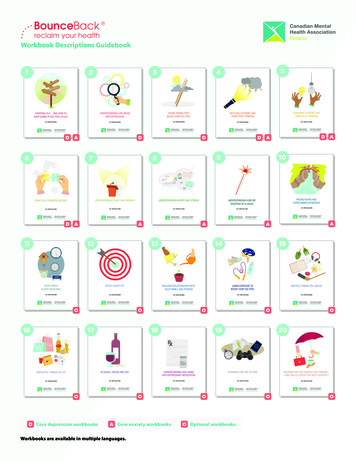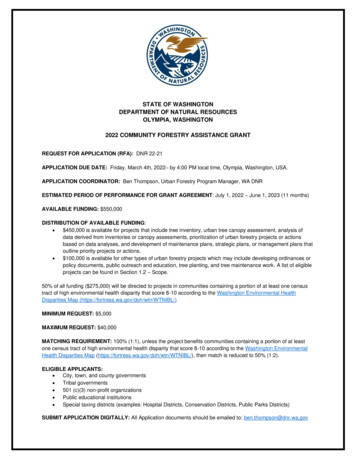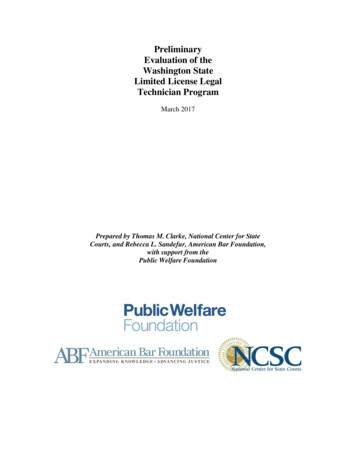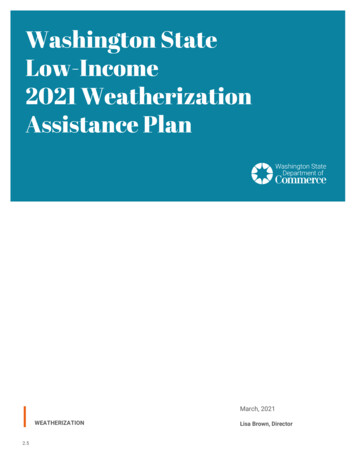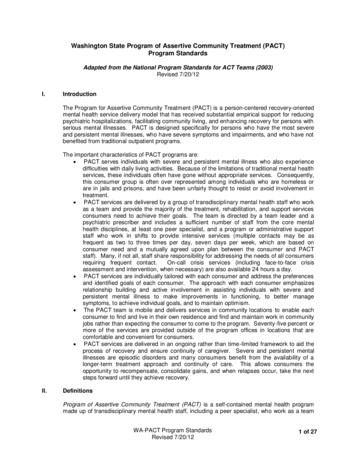
Transcription
Washington State Program of Assertive Community Treatment (PACT)Program StandardsAdapted from the National Program Standards for ACT Teams (2003)Revised 7/20/12I.IntroductionThe Program for Assertive Community Treatment (PACT) is a person-centered recovery-orientedmental health service delivery model that has received substantial empirical support for reducingpsychiatric hospitalizations, facilitating community living, and enhancing recovery for persons withserious mental illnesses. PACT is designed specifically for persons who have the most severeand persistent mental illnesses, who have severe symptoms and impairments, and who have notbenefited from traditional outpatient programs.The important characteristics of PACT programs are: PACT serves individuals with severe and persistent mental illness who also experiencedifficulties with daily living activities. Because of the limitations of traditional mental healthservices, these individuals often have gone without appropriate services. Consequently,this consumer group is often over represented among individuals who are homeless orare in jails and prisons, and have been unfairly thought to resist or avoid involvement intreatment. PACT services are delivered by a group of transdisciplinary mental health staff who workas a team and provide the majority of the treatment, rehabilitation, and support servicesconsumers need to achieve their goals. The team is directed by a team leader and apsychiatric prescriber and includes a sufficient number of staff from the core mentalhealth disciplines, at least one peer specialist, and a program or administrative supportstaff who work in shifts to provide intensive services (multiple contacts may be asfrequent as two to three times per day, seven days per week, which are based onconsumer need and a mutually agreed upon plan between the consumer and PACTstaff). Many, if not all, staff share responsibility for addressing the needs of all consumersrequiring frequent contact.On-call crisis services (including face-to-face crisisassessment and intervention, when necessary) are also available 24 hours a day. PACT services are individually tailored with each consumer and address the preferencesand identified goals of each consumer. The approach with each consumer emphasizesrelationship building and active involvement in assisting individuals with severe andpersistent mental illness to make improvements in functioning, to better managesymptoms, to achieve individual goals, and to maintain optimism. The PACT team is mobile and delivers services in community locations to enable eachconsumer to find and live in their own residence and find and maintain work in communityjobs rather than expecting the consumer to come to the program. Seventy-five percent ormore of the services are provided outside of the program offices in locations that arecomfortable and convenient for consumers. PACT services are delivered in an ongoing rather than time-Iimited framework to aid theprocess of recovery and ensure continuity of caregiver. Severe and persistent mentalillnesses are episodic disorders and many consumers benefit from the availability of alonger-term treatment approach and continuity of care. This allows consumers theopportunity to recompensate, consolidate gains, and when relapses occur, take the nextsteps forward until they achieve recovery.II.DefinitionsProgram of Assertive Community Treatment (PACT) is a self-contained mental health programmade up of transdisciplinary mental health staff, including a peer specialist, who work as a teamWA-PACT Program StandardsRevised 7/20/121 of 27
to provide the majority of treatment, rehabilitation, and support services consumers need toachieve their goals. PACT services are individually tailored with each consumer throughrelationship building, individualized assessment and planning, and active involvement withconsumers to enable each to find and live in their own residence, to find and maintain work incommunity jobs, to better manage symptoms, to achieve individual goals, and to maintainoptimism and recover. The PACT team is mobile and delivers services in community locationsrather than expecting the consumer to come to the program. Seventy-five percent or more of theservices are provided outside of program offices in locations that are comfortable and convenientfor consumers. The consumers served have severe and persistent mental illness that arecomplex, have devastating effects on functioning, and, because of the limitations of traditionalmental health services, may have gone without appropriate services. There should be no morethan 10 consumers to one staff member on each full team and no more than 8 consumers to onestaff member on each half team.Activities of Daily Living Services include approaches to support and build skills in a range ofactivities of daily living (ADLs), including but not limited to finding housing, performing householdactivities, carrying out personal hygiene and grooming tasks, money management, accessing andusing transportation resources, and accessing services from a physician and dentist.Clinical Supervision is a systematic process to review each consumer's clinical status and toensure that the individualized services and interventions that the team members provide areplanned with, purposeful for, effective, and satisfactory to the consumer. The team leader andthe psychiatric prescriber have the responsibility to provide clinical supervision which mayinclude: 1) meeting as a group (separately from the daily team meeting) or individually to discussspecific clinical cases; 2) field mentoring (e.g., helping staff by going out in the field with them toteach, role model skills, and providing feedback on skills); 3) reviewing and providing feedback onthe specific tools (e.g., the quality of assessments, treatment plans, progress notes); 4) didacticteaching and/or training; and 5) formal in-office individual supervision (including both impromptu,but at least 20 minutes in length, as well as scheduled).Comprehensive Assessment is the organized process of gathering and analyzing current andpast information with each consumer and the family and/or support system and other significantpeople to evaluate: 1) mental and functional status; 2) effectiveness of past treatment; 3) currenttreatment, rehabilitation and support needs to achieve individual goals and support recovery; and4) the range of individual strengths (e.g., knowledge gained from dealing with adversity orpersonal/professional roles, talents, personal traits) that can act as resources to the consumerand his/her recovery planning team in pursuing goals. The results of the information gatheringand analysis are used to: 1) establish immediate and longer-term service needs with eachconsumer; 2) set goals and develop the initial person-centered treatment plan with eachconsumer; and 3) optimize benefit that can be derived from existing strengths and resources ofthe individual and his/her family and/or natural support network in the community.Consumer is a person who has agreed to receive services and is receiving person-centeredtreatment, rehabilitation, and support services from the PACT team.Co-Occurring Disorders Services include integrated and stage-wise assessment and treatmentfor individuals who have a co-occurring mental health and substance use disorder. This type oftreatment is based on the short-term goal of risk and harm reduction and the long-term goal ofabstinence, following the services aligned with the integrated dual disorders treatment (IDDT)model.Crisis Assessment and Intervention includes coverage offered 24 hours per day, seven days perweek for consumers when consumers experience a crisis.Daily Log is a notebook, cardex, or computerized form which the PACT team maintains on a dailybasis to provide: 1) a roster of consumers served in the program; and 2) for each consumer, aWA-PACT Program StandardsRevised 7/20/122 of 27
brief documentation of any treatment or service contacts which have occurred within the past 24hours and a concise behavioral description of the consumer's clinical status and any additionalneeds.Daily Team Meeting is a daily staff meeting held at regularly scheduled times under the directionof the team leader (or designee) to: 1) briefly review the service contacts which occurred withinthe past 24 hours and the status of all program consumers; 2) review the service contacts whichare scheduled to be completed during the current day and revise as needed; 3) when not alreadyassigned within the weekly consumer schedule, assign staff to carry out the day's serviceactivities; and 4) plan for emergency and crisis situations as needed. The daily log and the dailystaff assignment schedule are used during the meeting to facilitate completion of these tasks.Daily Staff Assignment Schedule is a written, daily timetable summarizing all consumer treatmentand service contacts to be divided and shared by staff working on that day. The daily staffassignment schedule is developed from a central file of all weekly consumer schedules.Individual Treatment Team (ITT) is a combination (typically three to five) PACT staff memberswho together have a range of clinical and rehabilitation skills and expertise. The ITT membersare assigned by the team leader and the psychiatric prescriber to work collaboratively with aconsumer and his/her family and/or natural support members in the community by the time of theinitial person-centered treatment planning meeting or thirty days after admission. The coremembers are the primary practitioner, the psychiatric prescriber, and at least one clinical orrehabilitation staff person who shares case coordination and service provision tasks for eachconsumer. The ITT has continuous responsibility to be knowledgeable about the consumer’s life,circumstances, goals and desires; to collaborate with the consumer to develop and write thetreatment plan; to offer options and choices in the treatment plan; to ensure that immediatechanges are made as a consumer's needs change; and to advocate for the consumer’s wishes,rights, and preferences. The ITT is responsible to provide much of the consumer's treatment,rehabilitation, and support services. ITT members are assigned to take specific service roles withthe consumer as stated by the consumer and the ITT in the treatment plan.Individual Therapy includes verbal therapies that help people address their emotions, thoughts,and behaviors in order to progress toward their own personal recovery goals.Individualpsychotherapy may also help consumers understand and identify symptoms in order to findstrategies to lessen distress and symptomatology, improve individual role functioning, andevaluate treatment and rehabilitative services. Current psychotherapy approaches includesupportive therapy, cognitive behavioral therapy, personal therapy, and psychoeducati onaltherapy.Initial Assessment and Person-Centered Treatment Plan is the initial evaluation of: 1) theconsumer’s mental and functional status; 2) the effectiveness of past treatment; 3) the currenttreatment, and rehabilitation and support service needs, and 4) the range of individual strengthsthat can act as resources to the person and his/her ITT in pursuing goals. The results of theinformation gathering and analysis are used to establish the initial treatment plan to achieveindividual goals and support recovery. Completed the day of admission, the consumer’s initialassessment and treatment plan guides team services until the comprehensive assessment andfull person-centered treatment plan is completed.Medication Distribution is the physical act of giving medication to consumers in a PACT programby the prescribed route which is consistent with state law and the licenses of the professionalsprivileged to prescribe and/or administer medication (e.g., psychiatric prescribers, registerednurses, and pharmacists).Medication Error is any error in prescribing or administering a specific medication, including errorsin writing or transcribing the prescription, in obtaining and administering the correct medication, inthe correct dosage, in the correct form, and at the correct time.WA-PACT Program StandardsRevised 7/20/123 of 27
Medication Management is a collaborative effort between the consumer and the psychiatricprescriber with the participation of the ITT to carefully evaluate the consumer’s previousexperience with psychotropic medications and side-effects; to identify and discuss the benefitsand risks of psychotropic and other medication; to choose a medication treatment; and toestablish a method to prescribe and evaluate medication according to evidence-based practicestandards.PACT Primary Practitioner leads and coordinates the activities of the individual treatment team(ITT) and is the ITT member who has primary responsibility for establishing and maintaining atherapeutic relationship with a consumer on a continuing basis, whether the consumer is in thehospital, in the community, or involved with other agencies; he or she is the lead team member tobe knowledgeable about the consumer’s life, circumstances, goals and desires. The primarypractitioner ensures that all sections of the comprehensive assessment are completed byrespective team members. The primary practitioner also collaborates with the consumer and ITTto develop and write the person-centered treatment plan, ensures that immediate changes aremade as the consumer’s needs change, and advocates for the consumer’s wishes, rights, andpreferences. While the primary practitioner is the administrative and clinical lead for a particularconsumer, he or she shares all other service activities with other members of the ITT.Peer Support Services include coaching and consultation services which serve to validateconsumers' experiences, provide guidance and encouragement to consumers to takeresponsibility for and actively participate in their own recovery, and help consumers identify,understand, and combat stigma and discrimination against mental illness and develop strategiesto reduce consumers’ self-imposed stigma. Peer Support Services may be inclusive of WellnessManagement Services, such as facilitation of Wellness Recovery Action Plans (WRAP) andIllness Management and Recovery (IMR) services.Person-Centered Treatment Plan is the culmination of a continuing process involving eachconsumer, his/her family and/or natural supports in the community, and the PACT t eam, whichindividualizes service activity and intensity to meet the consumer’s specific treatment,rehabilitation, and support needs. The written treatment plan documents the consumer'sstrengths, resources, self-determined goals, and the services necessary to help the consumerachieve them. The plan also delineates the roles and responsibilities of the team members whowill work collaboratively with each consumer in carrying out the services.Psychoeducation and Support for Family and Natural Supports is an approach to working inpartnership with families and natural support members to provide current information aboutmental illness, resources available, and to teach coping and other behavioral skills for handlingproblems posed by mental illness as experienced by a significant other in their lives.Psychotropic Medication is any drug used to treat, manage, or control psychiatric symptoms ordisordered behavior, including but not limited to antipsychotic, antidepressant, mood-stabilizing orantianxiety agents.Service Coordination is a process of organization and coordination within the transdisciplinaryteam to carry out the range of treatment, rehabilitation, and support services each consumerexpects to receive per his or her written person-centered treatment plan and that are respectful ofthe consumer’s wishes. Service coordination also includes coordination with communityresources, including consumer self-help and advocacy organizations that promote recovery.Shift Manager is the individual who is typically office-based for all or part of the day, and ischarged with managing all emergencies or crises that arise during the course of the day, inconsultation with the team leader and the psychiatric prescriber. This is a rotating role amongteam members, assigned by the team leader.WA-PACT Program StandardsRevised 7/20/124 of 27
Social and Community Integration Skills Training includes services to support social andinterpersonal relationships and leisure time activities, with an emphasis on skills acquisition andgeneralization in integrated community-based settings.Stakeholder Advisory Groups support and guide individual PACT team implementation andoperation. Each PACT team shall have a Stakeholder Advisory Group whose membershipconsists of at least 51 percent mental health consumers and family members. It shall also includecommunity stakeholders that interact with persons with severe and persistent mental illness (e.g.,homeless services, food-shelf agencies, faith-based entities, criminal justice system, the housingauthority, landlords, employers, and community colleges). In addition, group membership shallrepresent the local cultural populations. The group’s primary function is to promote quality PACTprograms; monitor fidelity to the PACT Standards; guide and assist the administering agency'soversight of the PACT program; problem-solve and advocate to reduce barriers to PACTimplementation; and monitor/review types of and trends in consumer and family grievances andcomplaints. The Stakeholder Advisory Group promotes and ensures consumers’ empowermentand recovery values in PACT programs.Supported Education provides the opportunities, resources, and supports to individuals withmental illness so that they may gain admission to and succeed in the pursuit of post-secondaryeducation, including high school, GED, and vocational school,Transdisciplinary Approach specifies that team members share roles and systematically crossdiscipline boundaries. The primary purpose of this approach is to pool and integrate the expertiseof team members so that more efficient and comprehensive assessment and interventionservices may be provided. The communication style in this type of team involves continuous giveand-take among all members (inclusive of the consumer and, if desired, his/her family/othernatural supports) on a regular, planned basis. The role differentiation between disciplines isdefined by the needs of the situation rather than by discipline-specific characteristics. Thetransdisciplinary approach can be contrasted with the multidisciplinary approach in which teammembers independently carry out assessments and implement their own section of the treatmentplan, rather than in a cross-disciplinary, integrated fashion, which also serves to actively involvethe consumer in their own assessment and treatment.Treatment Plan Review is a thorough, written summary describing the consumer’s and the ITT’sevaluation of the consumer’s progress/goal attainment, the effectiveness of the interventions, andsatisfaction with services since the last person-centered treatment plan.Treatment Planning Meeting is a regularly scheduled meeting conducted under the supervision ofthe team leader and the psychiatric prescriber. The purpose of these meetings is for the staff, asa team, and the consumer and his/her family/natural supports, to thoroughly prepare for theirwork together. The group meets together to present and integrate the information collectedthrough assessment in order to learn as much as possible about the consumer’s life, his/herexperience with mental illness, and the type and effectiveness of the past treatment they havereceived. The presentations and discussions at these meetings make it possible for all staff to befamiliar with each consumer and his/her goals and aspirations and for each consumer to becomefamiliar with each ITT staff person; to participate in the ongoing assessment and reformulation ofstrengths, resources, and service needs/issues; to problem-solve treatment strategies andrehabilitation options; and to fully understand the treatment plan rationale in order to carry out theplan for each.Vocational Services follow the Individual Placement and Support (IPS) model of supportedemployment, adapted to team-based services within PACT. These include work-related servicesto help consumers value and understand the implications of, as well as find and maintainmeaningful competitive employment in community-based job sites. Vocational services alsoinclude job development and coordination with employers, brief vocational assessment and rapidWA-PACT Program StandardsRevised 7/20/125 of 27
referral, as well as job coaching and follow-along job supports provided to the consumer.Vocational services also include ongoing benefits counseling.Weekly Consumer Schedule is a written schedule of the specific interventions or service contacts(i.e., by whom, when, for what duration, and where) which fulfill the goals and objectives in agiven consumer’s person-centered treatment plan. The ITT shall maintain an up-to-date weeklyconsumer schedule for each consumer per the person-centered treatment plan.Wellness Management and Recovery Services are a combination of psychosocial approaches toworking with the consumer to build and apply skills related to his or her recovery, includingdevelopment of recovery strategies, psychoeducation about mental illness and the stressvulnerability model, building social support, reducing relapses, using medication effectively,coping with stress, symptom management, and getting needs met within the mental healthsystem and community. Examples of such services include Wellness Recovery Action Planning(WRAP) and Illness Management and Recovery (IMR).III.Admission and Discharge CriteriaA.Admission CriteriaIndividuals must meet the following admission criteria:1. Severe and persistent mental illness listed in the diagnostic nomenclature (currently theDiagnostic and Statistical Manual, Fifth Edition, or DSM V, of the American PsychiatricAssociation) that seriously impair their functioning in community living. Individuals musthave a primary mental health diagnosis and a major Axis I disorder. Priority is given topeople with schizophrenia, other psychotic disorders (e.g., schizoaffective disorder), andbipolar disorder because these illnesses more often cause long-term psychiatric disabilityand because of research supporting the effectiveness of PACT for persons with thesedisorders. The appropriateness of PACT services for persons without these primarydiagnoses is not supported by research and is of questionable appropriateness.Individuals with a sole diagnosis of a substance use disorder, mental retardation, braininjury or Axis II disorders are not the intended consumer group for PACT services.Individuals with severe mental illnesses who have not been able to remain abstinent fr omdrugs or alcohol will not be excluded from PACT services.2. Significant functional impairments as demonstrated by at least one of the followingconditions:a.Significant difficulty consistently performing the range of practical daily livingtasks required for basic adult functioning in the community (e.g., caring forpersonal business affairs; obtaining medical, legal, and housing services;recognizing and avoiding common dangers or hazards to self and possessions;meeting nutritional needs; maintaining personal hygiene) or persistent orrecurrent difficulty performing daily living tasks except with significant support orassistance from others such as friends, family, or relatives.b. Significant difficulty maintaining consistent employment at a self-sustaining levelor significant difficulty consistently carrying out the homemaker role (e.g.,household meal preparation, washing clothes, budgeting, or child -care tasks andresponsibilities).c. Significant difficulty maintaining a safe living situation (e.g., repeated evictions orloss of housing).WA-PACT Program StandardsRevised 7/20/126 of 27
3. Continuous high-service needs as demonstrated by at least one of the following:a.High use of acute psychiatric hospitals (e.g., two or more admissions per year) orpsychiatric emergency services.b. Intractable (i.e., persistent or very recurrent) severe major symptoms (e.g.,affective, psychotic, suicidal).c. Co-occurring substance use disorder of significant duration (e.g., greater than sixmonths).d. High risk or recent history of criminal justice involvement (e.g., arrest andincarceration).e. Significant difficulty meeting basic survival needs or residing in substandardhousing, homelessness, or at imminent risk of becoming homeless.f. Residing in an inpatient or supervised community residence, but clinicallyassessed to be able to live in a more independent living situation if intensiveservices are provided, or requiring a residential or institutional placement if moreintensive services are not available.g. Difficulty effectively utilizing or benefiting from traditional office-based outpatientservices or other less-intensive community-based programs (e.g., consumer failsto progress, drops out of service).4. Documentation of admission shall include:a. The reasons for admission as stated by both the consumer and the PACT team.b. The signature of the psychiatric prescriber.B.Discharge Criteria1. Discharges from the PACT team occur when consumers and PACT staff mutually agreeto the termination of services. This shall occur when consumers:a.Have successfully reached individually established goals for discharge and whenthe consumer and program staff mutually agree to graduation from PACTservices.b. Move outside the geographic area of PACT's responsibility. In such cases, thePACT team shall arrange for transfer of mental health service responsibility to aPACT program or another provider wherever the consumer is moving. The PACTteam shall maintain contact with the consumer until this service transfer iscompleted.c. Demonstrate an ability to function in all major role areas (i.e., work, social, selfcare) without requiring ongoing assistance from the program for six to ninemonths without significant relapse when services are withdrawn.d. Decline or refuse services and request discharge, despite the team's best effortsto develop an acceptable person-centered treatment plan with the consumer.2. In addition to the discharge criteria listed above based on mutual agreement between theconsumer and PACT staff, a consumer discharge may also be facilitated due to any oneof the following circumstances:a. Death.b. Inability to locate the consumer for a prolonged period of time.c. Long-term incarceration.d. Long-term hospitalization where it has been determined based on mutualagreement by the hospital treatment team and the PACT team that the consumerwill not be appropriate for discharge for a prolonged period of time.WA-PACT Program StandardsRevised 7/20/127 of 27
3. If the consumer is accessible at the time of discharge (i.e., according to circumstanceslisted under III.B.1 above), the team shall ensure consumer participation in all dischargeactivities, as evidenced by documentation as described below:a. The reasons for discharge as stated by both the consumer and the PACT team.b. The consumer's biopsychosocial status at discharge.c. A written final evaluation summary of the consumer's progress toward the goalsset forth in the person-centered treatment plan.d. A plan developed in conjunction with the consumer for follow-up treatment afterdischarge.e. The signature of the consumer, the consumer's primary practitioner, the teamleader, and the psychiatric prescriber.4. When clinically necessary, the team will make provisions for expedited re-entry ofdischarged consumers as rapidly as possible and will prioritize them on the admissionand/or waiting list.Policy and Procedure Requirements: The PACT team shall maintain written admission and dischargepolicies and procedures.IV.Service Intensity and CapacityA.Staff-to-Consumer RatioEach PACT team shall have the organizational capacity to provide a minimum staff-toconsumer ratio of at least one full-time equivalent (FTE) staff person for every 10 consumers(not including the psychiatric prescriber and the program assistant) for a full team. Halfteams shall have the organizational capacity to provide a minimum staff-to-consumer ratio ofat least one full-time equivalent (FTE) staff person for every 8 consumers (not including thepsychiatric prescriber and the program assistant).B.Staff CoverageEach PACT team shall have sufficient numbers of staff to provide treatment, rehabilitation,and support services seven days per week, as well as crisis intervention coverage 24 hours aday.C.Frequency of Consumer Contact1. The PACT team shall have the capacity to provide multiple contacts per week withconsumers experiencing severe symptoms, trying a new medication, experiencing ahealth problem or serious life event, trying to go back to school or starting a new job,making changes in living situation or employment, or having significant ongoing problemsin daily living. These multiple contacts may be as frequent as two to three times per day,seven days per week and depend on consumer need and a mutually agreed upon planbetween consumers and program staff. Many, if not all, staff shall share responsibility foraddressing the needs of all consumers requiring frequent contact.2. The PACT team shall have the capacity to rapidly increase service intensity to aconsumer when his or her status requires it or a consumer requests it.3. The PACT team shall provide an average of three face-to-face contacts per week for allconsumers. Data regarding the frequency of consumer contacts shall be collected andreviewed as part of the program’s performance improvement plan.WA-PACT Program StandardsRevised 7/20/128 of 27
D.Gradual Admission of Team ConsumersEach new PACT team shall stagger consumer admissions (i.e., no more than 4 consumersper month) to gradually
The Program for Assertive Community Treatment (PACT) is a person-centered recovery-oriented mental health service delivery model that has received substantial empirical support for reducing psychiatric hospitalizations, facilitating community living, and enhancing recovery for persons with

